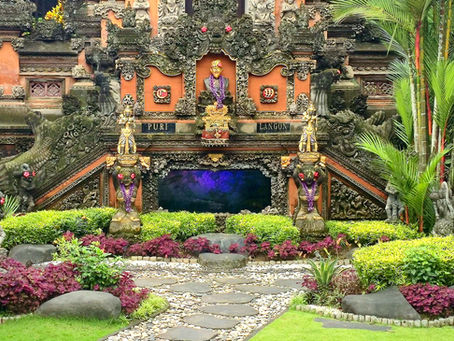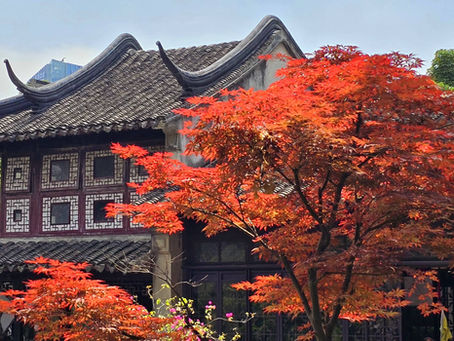top of page

GLOBAL SHANANIGANS

Search


Ayung River Rafting - Bali's Scenic Waterway
The Ayung River is Bali’s longest waterway, stretching 68.5 km's from the lush northern highlands down to the southern coast at Sanur. It snakes its way through deep gorges, remote jungles, rice terraces and traditional villages, making it one of the island’s most scenic natural features. Despite its size, the Ayung maintains a gentle flow for much of its length, making it ideal for outdoor activities like rafting and river trekking.
Shannon


Goa Lawah Bat Cave Temple
On Bali’s southeastern coast, Goa Lawah Bat Cave Temple stands out as a powerful spiritual site where myth and nature collide. With thousands of bats roosting above its shrines, this atmospheric temple offers a raw glimpse into the island’s ancient traditions.
Shannon


Puri Langon Temple
Puri Langon is a privately owned royal compound located in central Ubud. It is the personal residence of Tjokorda Ngurah Suyadnya, better known as Cok Wah, a respected figure in the Ubud royal family. Though it remains a functioning private home, Puri Langon is open to the public free of charge, offering rare access to a lived-in royal space that continues to serve spiritual and cultural functions within the community.
Shannon


Uluwatu Temple
Overlooking the vast and turbulent Indian Ocean on Bali’s Bukit Peninsula, Uluwatu Temple (or Pura Luhur Uluwatu) perches 70 metres above the waves, a landmark of both awe and solemnity. Archaeological evidence shows its origins date back to the 9th century, based on an ancient split gateway bearing a chronogram marking 886 .AD, confirming its megalithic roots as one of the island’s oldest sacred sites
Shannon


Carved in Time - Khuổi Ky Stone Village
Known for its striking stone architecture and deeply rooted cultural traditions, Khuổi Ky’s origins trace back over 400 years and was established by the ancient Tay ethnic tribe, after 2,000 years of hardship and migration from the southern regions of China and Cambodia. The Tay people, one of Vietnam’s oldest and most culturally rich ethnic groups, are believed to have journeyed across generations, seeking fertile land and spiritual sanctuary.
Shannon


The Lingering Garden
In a city celebrated for its canals, silk and scholars, Suzhou’s Lingering Garden represents a pinnacle of classical Chinese garden design. Often referred to as one of the “Four Great Classical Gardens of China,” it embodies centuries of artistic refinement and philosophical thought. Built in 1593 during the Ming dynasty by Xu Taishi, a high-ranking official who sought retirement and tranquility, the garden stands as a personal reflection of his scholarly ideals.
Shannon


Bạch Mã Temple
Bạch Mã Temple, the oldest temple in Hanoi’s Old Quarter, traces its origins back to the year 1010, during the reign of Emperor Lý Thái Tổ. It is one of four sacred temples in the city, constructed to stand as a spiritual guardian for the eastern side of ancient Thang Long (modern-day Hanoi) and was carefully chosen according to the principles of geomancy and the cardinal points.
Shannon


Love Waterfall and the Fairy’s Curse
Located about 13km's down a winding alpine road from Sa Pa town, the majestic Silver Waterfall thunders 200 metres down the cliffs of the Hoàng Liên Son Mountains from the headwaters of the Lo Sui Tong peak. Known to locals as "Thác Bạc" the falls are fed by glacial runoff that originate near the summit of Fansipan, the highest peak and "Roof of Indochina"
Shannon


Hỏa Lò Prison
Constructed by the French in 1896 as part of their broader strategy to subjugate Vietnam under colonial rule, Hỏa Lò Prison was built to break the will of Vietnamese revolutionaries and political dissidents. Intended to hold 450 inmates, it regularly crammed in over 2000, locking men and women into rotting, airless cells that stank of urine, sweat and blood. It became a crucible of suffering, where countless resistance leaders endured torture, starvation and isolation.
Shannon


Bản Giốc Waterfalls
Carved by the Quây Sơn River, this magnificent tiered waterfall spans about 300 metres in width and cascades down 30 meters, making it the largest natural falls in Southeast Asia and the fourth largest transboundary waterfall in the world. Located on a remote border between Vietnam’s Cao Bằng Province and China’s Guangxi region, the Bản Giốc Waterfall (known as the Detian Falls in China) is one of Asia’s most spectacular natural wonders, rivalling Plitvice in Croatia.
Shannon


Yu Garden - The Heart of Old Shanghai
Located in Shanghai's historic Old City near the City God Temple, Yu Garden is one of the best preserved examples of classical Chinese garden design. It was originally constructed in 1559 during the Ming Dynasty by Pan Yunduan, a high ranking imperial officer. Pan built the garden as a retirement retreat for his aging father, Pan En, intending it to be a place of comfort and tranquility. The name Yu itself means peace and contentment, symbolising his filial piety.
Shannon


Jingjiang Princes’ Palace
The Jingjiang Princes’ Palace, constructed in 1372 during the early Ming Dynasty, served as the residence of Zhu Shouqian, a nephew of the dynasty’s founding Emperor Zhu Yuanzhang. Perched at the foot of Duxiu Hill in Guilin, the palace was more than just a lavish estate, it embodied the Ming strategy of installing Vassal Kings across the Empire to maintain dynastic stability and guard the frontiers.
Shannon


Ta Som Temple - Echoes of Stone
Tucked quietly in the northern stretches of the Angkor Archaeological Park lies Ta Som, a temple often overshadowed by its grander neighbours but brimming with enigmatic charm. Built in the late 12th century under the reign of King Jayavarman VII, one of the most prolific temple builders in Cambodian history, Ta Som is a smaller-scale reflection of the Bayon style, marked by smiling stone faces and Buddhist symbolism.
Shannon


The Dark Reign of Jiajing - Death by a Thousand Cuts
The Jiajing Emperor, who ruled China’s Ming Dynasty from 1521 to 1567, is often remembered for his sadistic and tyrannical reign marked by cruelty, decadence and obsession with immortality. His relentless pursuit of eternal life led him to engage in dark and brutal practices, one of the most notorious being his bloodlust for a substance called “red lead.” This concoction was allegedly made using the menstrual blood of young virgin girls.
Shannon


Sacred Nara Deer Park
Although not formally declared a public park until 1880, the sacred origins of Nara Park stretch back to 708AD, when Japan’s capital was transferred to the Heijo Palace area, now the city of Nara. As the heart of early Japanese civilisation, Nara became a place where political ambition, religious reverence and spiritual mystery intertwined.
Shannon


The Marble Mountains
Just south of Da Nang on Vietnam’s central coast, the Marble Mountains (Ngu Hành Sơn) rise like ancient sentinels above the surrounding flatlands. These five striking limestone and marble hills are each named after one of the five elements of Eastern philosophy: metal (Kim), wood (Mộc), water (Thủy), fire (Hỏa) and earth (Thổ). Steeped in legend and spirituality, the mountains have long served as places of worship and retreat.
Shannon


Kongōbu-ji Temple - The Heart of Shingon Buddhism
Founded in 1593 by the powerful samurai warlord Toyotomi Hideyoshi, Kongōbu-ji was established as a spiritual monument dedicated to immortalising his mother. This temple’s creation was more than just an act of filial piety, it became a lasting symbol of religious devotion and architectural mastery. Nestled in Koyasan, Kongōbu-ji quickly rose to prominence as a central hub for Shingon Buddhism, intertwining Hideyoshi’s legacy with the sacred landscape of Japan.
Shannon


Yaoshan Mountain - The Roof of Guilin
Yaoshan Mountain scenic area, standing at 909 metres, received its name in 221 BC with the construction of the Yao Emperor Temple at its summit. As the tallest peak in the Guilin region, it offers breathtaking panoramic views of the surrounding karst landscape, limestone formations that define the area’s iconic scenery. This early naming coincided with the unification of China under the Qin Dynasty, marking Yaoshan as a site of both natural prominence and emerging cultural si
Shannon


Sacred Mount Kōyasan
Mount Kōya, or Kōyasan, was first settled in 819AD by the legendary monk Kūkai, also known as Kōbō Daishi, who introduced esoteric Shingon Buddhism to Japan after studying in China. Nestled in a secluded alpine basin surrounded by eight lotus-like peaks, this sacred site in Wakayama Prefecture was chosen for its geomantic significance and spiritual isolation. By imperial decree in 816, Kūkai began transforming the mountaintop into a monastic haven.
Shannon


Zhangjiajie Glass Bridge
When the Zhangjiajie Glass Footbridge opened to the public in August 2016, it instantly shattered world records as the highest and longest glass bottomed suspension bridge. Stretching 430 metres across and suspended 300 metres above the Zhangjiajie Grand Canyon, it connects the dramatic cliffs of Yuanjiajie and Tianzi Mountains, terrain said to have inspired the floating mountains in Avatar.
Shannon
bottom of page